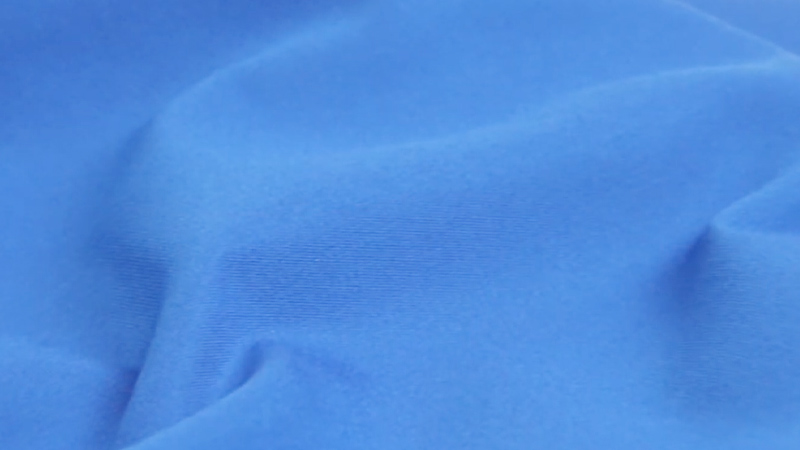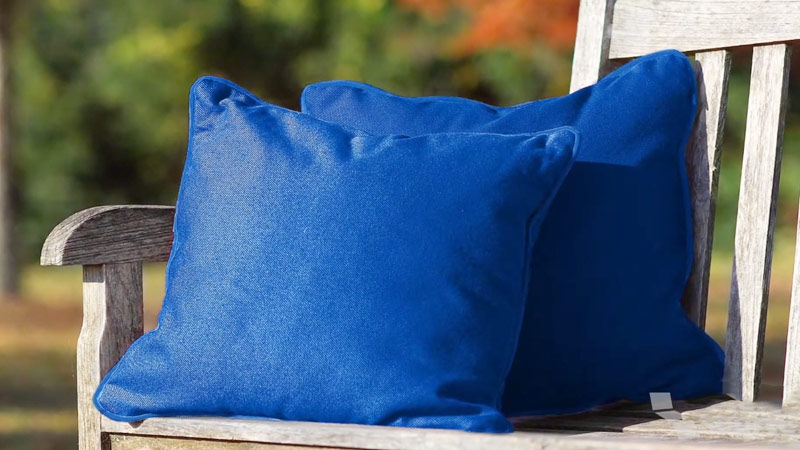Dyeing Sunbrella fabric can be done, but it requires specific techniques and considerations to achieve the best results. However, there might be instances when you desire a new color or wish to refresh the appearance of your Sunbrella fabric.
While dyeing Sunbrella presents unique challenges due to its solution-dyed acrylic fibers and inherent colorfastness, it is indeed possible with the right techniques and considerations.
This article explores the various dyeing methods, preparation steps, potential challenges, and alternative approaches to help you make an informed decision about dyeing your Sunbrella fabric and extending its life with a refreshed look.

Can You Dye Sunbrella Fabric?
Sunbrella fabric is a popular and highly durable outdoor fabric that is known for its resistance to fading, mildew, and stains. It is commonly used for various outdoor applications, including patio furniture, awnings, cushions, and boat covers.
While Sunbrella fabrics come in a wide range of colors and patterns, there may be instances when you want to change or refresh the color to suit your preferences or update your outdoor decor.
Understanding Sunbrella Fabric
Sunbrella fabric is made of 100% solution-dyed acrylic fibers, which means the color is added during the manufacturing process before the fibers are spun into yarn. Unlike traditional fabrics, where the color is applied on the surface, Sunbrella’s color permeates the entire fiber, making it highly resistant to fading and bleach cleanable.
This inherent colorfastness poses challenges when it comes to dyeing the fabric, as the dye must penetrate the fibers effectively to achieve the desired color change.
Dyeing Methods
There are different methods to dye Sunbrella fabric, each with its own advantages and challenges. The most common approaches include:
Fabric Dyes

Using fabric dyes specifically formulated for acrylic fibers is one of the best methods for dyeing Sunbrella. These dyes are designed to penetrate the fibers deeply, ensuring a lasting and even color.
It’s essential to choose dyes that work well with acrylic materials and follow the manufacturer’s instructions precisely. Fabric dyes often come in liquid or powder form and require mixing with water before application.
Spray Dyeing
Spray dyeing is a technique where the dye is sprayed onto the fabric’s surface. While this method can work for some fabrics, it may not be the most effective for Sunbrella.
Due to the fabric’s tightly woven and colorfast nature, spray dyeing might not provide sufficient penetration to achieve a consistent and long-lasting color change.
Dip Dyeing
Dip dyeing involves submerging the entire fabric in a dye bath. This method can be more effective than spray dyeing since it allows for better penetration of the dye.
However, the success of dip dyeing Sunbrella fabric depends on the dye type used, the immersion duration, and the fabric’s specific characteristics.
Preparation and Precautions
Before you start dyeing Sunbrella fabric, it is crucial to prepare properly and take necessary precautions to ensure the best results:
Clean the Fabric
Thoroughly clean the fabric to remove any dirt, stains, or chemical treatments that may hinder dye absorption. Use a mild detergent and water to wash the fabric, and allow it to dry completely before dyeing.
Test the Dye
Always perform a dyeing test on a small, inconspicuous area of the fabric to check the color result and evaluate the dye’s compatibility with Sunbrella. This step helps prevent undesirable outcomes on the entire fabric.
Work in a Well-Ventilated Area
Dyeing can involve the use of chemicals, so it’s essential to work in a well-ventilated area and wear appropriate protective gear, such as gloves and a mask, to avoid inhaling fumes or direct skin contact.
Control Water Temperature
Maintain a consistent water temperature throughout the dyeing process, as fluctuations can impact color absorption and result in uneven dyeing.
Dyeing Process
The exact dyeing process will vary depending on the dye type and method chosen.
However, a general dyeing process for Sunbrella fabric may include the following steps:
- Prepare the Dye Bath: If using fabric dye, mix the dye with water according to the manufacturer’s instructions. Ensure the dye is fully dissolved in the water before proceeding.
- Immerse the Fabric: Carefully dip the Sunbrella fabric into the dye bath, ensuring it is entirely submerged. Stir the fabric gently to ensure even dye penetration.
- Monitor the Dyeing Time: The duration the fabric remains in the dye bath will determine the color intensity. Keep track of the time to achieve the desired color result. Remember that Sunbrella fabrics can take longer to absorb dye compared to regular fabrics.
- Rinse and Dry: Once the desired color is achieved, remove the fabric from the dye bath and rinse it thoroughly with cool water until the water runs clear. Hang the fabric to dry in a shaded area away from direct sunlight.
Challenges and Limitations to Dye Sunbrella Fabric
While dyeing Sunbrella fabric is possible, it is essential to acknowledge the potential challenges and limitations associated with the process:
Colorfastness
Sunbrella’s inherent colorfastness can make it difficult for the new dye to fully penetrate the fibers, affecting the color’s vibrancy and longevity. The results might not be as predictable as dyeing regular fabrics.
Limited Color Change
Due to the fabric’s existing color, the range of colors achievable through dyeing may be limited. Attempting to achieve drastically different colors from the original may yield unsatisfactory results.
Uneven Dyeing
Achieving a perfectly even color distribution across the fabric can be challenging, particularly if the dye does not penetrate the fibers uniformly.
Fabric Characteristics
The tight weave and water-resistant properties of Sunbrella can affect dye absorption, which may lead to variations in color intensity.
Alternatives to Dyeing
If dyeing Sunbrella fabric proves too challenging or risky, there are alternative ways to update the fabric’s color or appearance:
Fabric Paint
Using fabric paints specially formulated for acrylic fabrics is an option to consider. Fabric paint sits on the fabric’s surface, providing color without fully penetrating the fibers. This can be an easier way to achieve color changes, but the final result might not be as permanent as dyeing.
Custom Sunbrella Fabrics
Sunbrella offers a wide range of colors and patterns. Exploring the existing options or contacting Sunbrella directly to inquire about custom color options might be a simpler way to find the desired color.
How to Make Your Sunbrella Fabric Last Longer
Extending the lifespan of your Sunbrella fabric is essential to maximize your investment in outdoor textiles. Sunbrella is known for its durability, but proper care and maintenance can significantly prolong its life.
Here are some tips to help you make your Sunbrella fabric last longer:
Regular Cleaning
Frequent cleaning is crucial to prevent dirt, debris, and stains from building up on the fabric. Remove loose dirt and debris by brushing or shaking off the fabric regularly. For more thorough cleaning, follow the manufacturer’s instructions and use a mild soap and water solution to clean the fabric. Rinse thoroughly and allow it to air dry completely before using or storing it.
Immediate Stain Removal
Deal with stains as soon as possible to prevent them from setting into the fabric. Blot liquid spills with a clean, dry cloth, and gently scrape off solid stains before cleaning the affected area. Avoid using harsh chemicals or bleach, as they may damage the fabric’s color and coating.
Protect from Mold and Mildew
Sunbrella is naturally resistant to mold and mildew growth, but in humid or damp environments, it’s essential to store and cover the fabric properly when not in use. Allow the fabric to dry completely before storing it to prevent mold and mildew from forming.
Proper Storage
During extended periods of non-use, store your Sunbrella fabric in a clean, dry, and well-ventilated area. Keep it away from direct sunlight, which can cause fading over time. Use protective covers to shield the fabric from dust, dirt, and other environmental elements.
Avoid Sharp Objects
Sunbrella fabric is durable, but it’s best to avoid placing sharp objects on it or subjecting it to rough handling. Sharp edges or rough treatment can cause snags, tears, or abrasions on the fabric.
Use Mildew-Resistant Foam
If you have outdoor cushions or pillows made with Sunbrella fabric, ensure that the foam inserts are mold and mildew resistant. High-quality foam will reduce the risk of moisture buildup within the cushions, extending their lifespan.
Avoid Prolonged Sun Exposure
While Sunbrella is designed to resist fading, excessive exposure to direct sunlight over extended periods can still affect its color. To protect the fabric from fading, consider using shading solutions like umbrellas or awnings.
Regular Inspections
Inspect your Sunbrella fabric periodically for signs of wear, tear, or damage. Address any issues promptly to prevent them from worsening.
Follow Manufacturer Guidelines
Always follow the care and maintenance instructions provided by the Sunbrella manufacturer. Each product may have specific recommendations for cleaning and care, and following these guidelines will ensure optimal performance and longevity.
Consider Weather Conditions
In regions with harsh weather conditions, such as extreme heat, cold, or heavy rainfall, take extra precautions to protect your Sunbrella fabric. Consider using additional covers or storing the fabric indoors during inclement weather.
Avoid High Heat
Keep Sunbrella fabric away from high heat sources, such as grills or fire pits, as prolonged exposure to extreme heat can damage the fabric.
FAQS
Can I use regular fabric dye from a craft store to dye Sunbrella fabric?
Using regular fabric dye from a craft store may not yield satisfactory results on Sunbrella fabric. Sunbrella’s unique solution-dyed acrylic fibers require dyes specifically formulated for acrylic materials.
Can I dye a patterned Sunbrella fabric to change its color?
Dyeing a patterned Sunbrella fabric to change its color can be challenging. The existing pattern is an integral part of the fabric’s design, and dyeing may not fully cover or alter the pattern.
Will dyeing Sunbrella fabric affect its water and stain-resistant properties?
Dyeing Sunbrella fabric with proper fabric dyes should not significantly affect its water and stain-resistant properties. The fabric’s inherent resistance to water and stains comes from the solution-dyed acrylic fibers, which are not significantly altered during the dyeing process.
Can I dye Sunbrella fabric that has been treated with a water repellent or stain-resistant coating?
Dyeing Sunbrella fabric that has been treated with a water repellent or stain-resistant coating may yield less predictable results. It’s advisable to remove any previous treatments from the fabric before dyeing by thoroughly cleaning and rinsing it.
Conclusion
While dyeing Sunbrella fabric can be challenging, it is achievable with the appropriate methods and precautions. Using fabric dyes specifically formulated for acrylic fibers and following proper preparation and dyeing techniques are essential for optimal results.
It’s crucial to keep in mind the fabric’s inherent colorfastness and limited color change potential when embarking on a dyeing project. If dyeing proves too intricate or risky, alternative options like fabric paints or exploring Sunbrella’s existing color range can still offer ways to update your outdoor textiles.
By carefully considering your goals, performing dye tests, and prioritizing the fabric’s care, you can enjoy your Sunbrella fabric’s beauty and functionality for years to come.
Leave a Reply